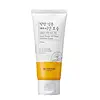What's inside
What's inside
 Key Ingredients
Key Ingredients

 Benefits
Benefits

 Concerns
Concerns

No concerns
 Ingredients Side-by-side
Ingredients Side-by-side

Water
Skin ConditioningGlycerin
HumectantOlea Europaea Fruit Oil
MaskingHelianthus Annuus Seed Oil
EmollientMacadamia Ternifolia Seed Oil
EmollientSqualane
EmollientHydrogenated Lecithin
EmulsifyingMangifera Indica Seed Butter
Skin ConditioningBetaine
HumectantHoney Extract
HumectantRoyal Jelly Extract
Skin ConditioningBeta-Glucan
Skin ConditioningPortulaca Oleracea Extract
Skin ConditioningPhytosteryl/Octyldodecyl Lauroyl Glutamate
Skin ConditioningEthylhexylglycerin
Skin ConditioningCeramide AP
Skin Conditioning1,2-Hexanediol
Skin ConditioningSodium Carbomer
Emulsion StabilisingCarbomer
Emulsion StabilisingChamomilla Recutita Flower Extract
MaskingAloe Barbadensis Leaf Juice Powder
Skin ConditioningXanthan Gum
EmulsifyingHydroxyethylcellulose
Emulsion StabilisingWater, Glycerin, Olea Europaea Fruit Oil, Helianthus Annuus Seed Oil, Macadamia Ternifolia Seed Oil, Squalane, Hydrogenated Lecithin, Mangifera Indica Seed Butter, Betaine, Honey Extract, Royal Jelly Extract, Beta-Glucan, Portulaca Oleracea Extract, Phytosteryl/Octyldodecyl Lauroyl Glutamate, Ethylhexylglycerin, Ceramide AP, 1,2-Hexanediol, Sodium Carbomer, Carbomer, Chamomilla Recutita Flower Extract, Aloe Barbadensis Leaf Juice Powder, Xanthan Gum, Hydroxyethylcellulose
Hydrolyzed Collagen
EmollientPropanediol
SolventWater
Skin ConditioningGlycerin
HumectantButylene Glycol
HumectantPentaerythrityl Tetraethylhexanoate
EmollientMethyl Trimethicone
Skin ConditioningGlyceryl Polymethacrylate
1,2-Hexanediol
Skin ConditioningBetaine
HumectantHydrogenated Poly(C6-14 Olefin)
EmollientDicaprylyl Ether
EmollientGlyceryl Stearate
EmollientC14-22 Alcohols
Emulsion StabilisingAmmonium Acryloyldimethyltaurate/Vp Copolymer
Glyceryl Stearate Citrate
EmollientHydroxyethyl Acrylate/Sodium Acryloyldimethyl Taurate Copolymer
Emulsion StabilisingArachidyl Alcohol
EmollientSilica
AbrasiveBehenyl Alcohol
EmollientC12-20 Alkyl Glucoside
EmulsifyingArachidyl Glucoside
EmulsifyingGlyceryl Caprylate
EmollientDisodium EDTA
Ethylhexylglycerin
Skin ConditioningSorbitan Isostearate
EmulsifyingHydrolyzed Lupine Protein
Skin ConditioningGlucose
HumectantTocopherol
AntioxidantHydrolyzed Collagen, Propanediol, Water, Glycerin, Butylene Glycol, Pentaerythrityl Tetraethylhexanoate, Methyl Trimethicone, Glyceryl Polymethacrylate, 1,2-Hexanediol, Betaine, Hydrogenated Poly(C6-14 Olefin), Dicaprylyl Ether, Glyceryl Stearate, C14-22 Alcohols, Ammonium Acryloyldimethyltaurate/Vp Copolymer, Glyceryl Stearate Citrate, Hydroxyethyl Acrylate/Sodium Acryloyldimethyl Taurate Copolymer, Arachidyl Alcohol, Silica, Behenyl Alcohol, C12-20 Alkyl Glucoside, Arachidyl Glucoside, Glyceryl Caprylate, Disodium EDTA, Ethylhexylglycerin, Sorbitan Isostearate, Hydrolyzed Lupine Protein, Glucose, Tocopherol
 Reviews
Reviews

Ingredients Explained
These ingredients are found in both products.
Ingredients higher up in an ingredient list are typically present in a larger amount.
1,2-Hexanediol is a synthetic liquid and another multi-functional powerhouse.
It is a:
- Humectant, drawing moisture into the skin
- Emollient, helping to soften skin
- Solvent, dispersing and stabilizing formulas
- Preservative booster, enhancing the antimicrobial activity of other preservatives
Betaine is a common humectant (a substance that promotes retention of moisture). It's known to be gentle on the skin and can help balance hydration.
This ingredient is best for improving hydration and soothing irritated skin. Studies also show it helps even out skin tone.
Fun fact: Betaine is naturally created in the skin and body. The kind found within cosmetic products can be either plant-derived or synthetic.
Another name for betaine is trimethylglycine.
Learn more about BetaineEthylhexylglycerin (we can't pronounce this either) is commonly used as a preservative and skin softener. It is derived from glyceryl.
You might see Ethylhexylglycerin often paired with other preservatives such as phenoxyethanol. Ethylhexylglycerin has been found to increase the effectiveness of these other preservatives.
Glycerin is already naturally found in your skin. It helps moisturize and protect your skin.
A study from 2016 found glycerin to be more effective as a humectant than AHAs and hyaluronic acid.
As a humectant, it helps the skin stay hydrated by pulling moisture to your skin. The low molecular weight of glycerin allows it to pull moisture into the deeper layers of your skin.
Hydrated skin improves your skin barrier; Your skin barrier helps protect against irritants and bacteria.
Glycerin has also been found to have antimicrobial and antiviral properties. Due to these properties, glycerin is often used in wound and burn treatments.
In cosmetics, glycerin is usually derived from plants such as soybean or palm. However, it can also be sourced from animals, such as tallow or animal fat.
This ingredient is organic, colorless, odorless, and non-toxic.
Glycerin is the name for this ingredient in American English. British English uses Glycerol/Glycerine.
Learn more about GlycerinWater. It's the most common cosmetic ingredient of all. You'll usually see it at the top of ingredient lists, meaning that it makes up the largest part of the product.
So why is it so popular? Water most often acts as a solvent - this means that it helps dissolve other ingredients into the formulation.
You'll also recognize water as that liquid we all need to stay alive. If you see this, drink a glass of water. Stay hydrated!
Learn more about Water